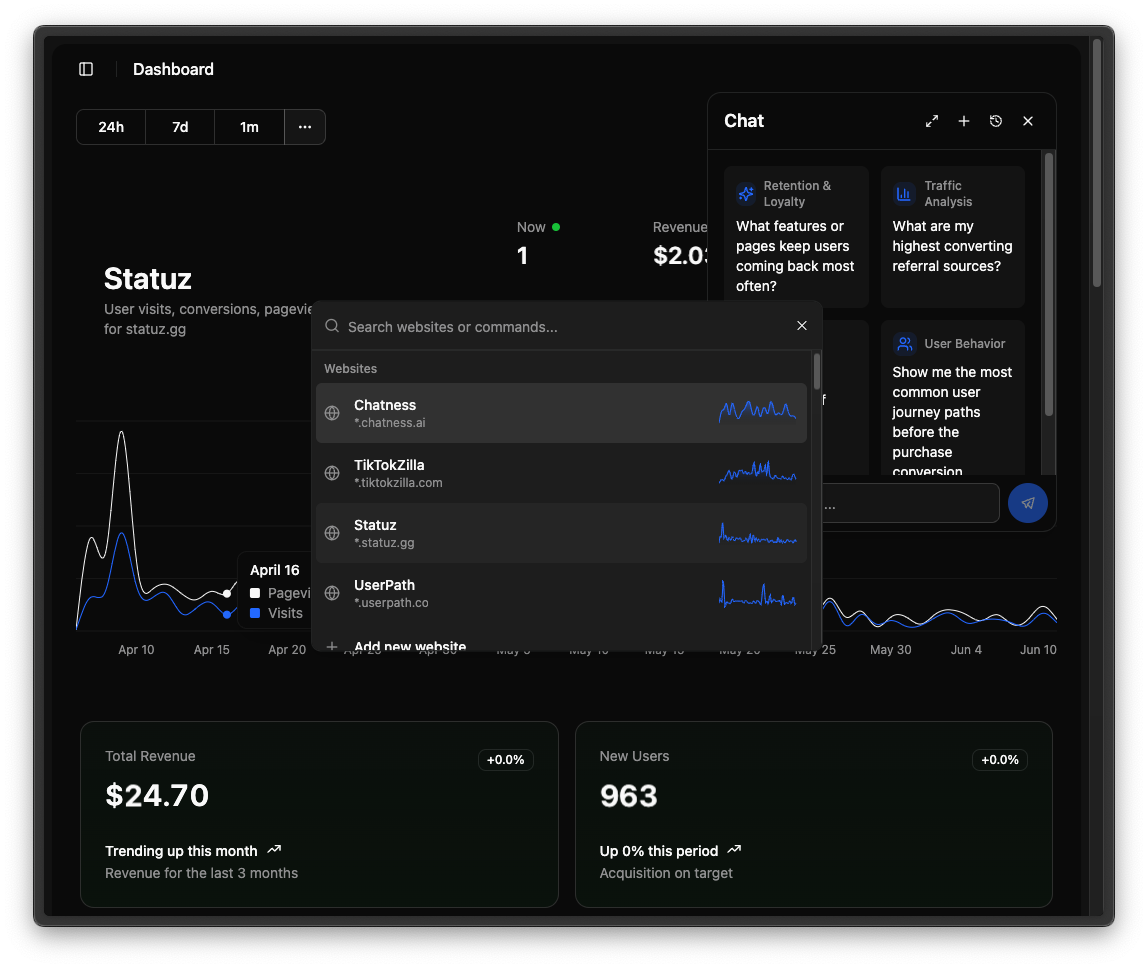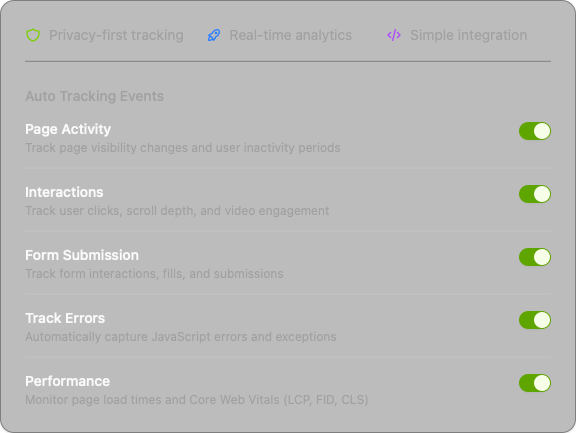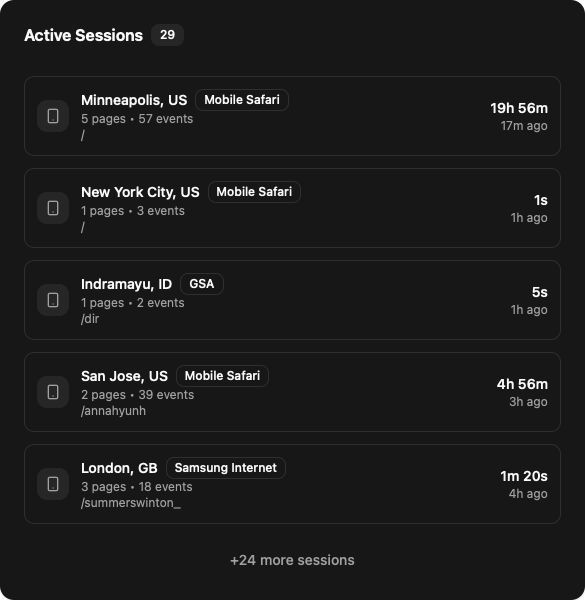UserPath is an AI-powered analytics platform designed as a modern alternative to Google Analytics. Built with a focus on reliability, performance, and data privacy, UserPath offers first-party integration capabilities that allow you to collect and analyze user data directly from your own servers preventing it from being blocked by ad blockers plugins and privacy-first browsers like Brave and DuckDuckGo.
Why Choose UserPath?
Core Features
UserPath provides everything you need to understand your users and optimize your product:

- Real-time chat with data
- Smart insights generation
- Custom dashboard creation
- Automated reporting
- Conversion optimization suggestions

- No cross-site tracking
- First-party data collection
- Password fields never tracked
- Form values not captured
- Comprehensive data deletion

- Live visitor tracking
- Real-time event monitoring
- Performance metrics
- Geographic distribution
- Live goal tracking
Key Concepts
Understanding these core concepts will help you get the most out of UserPath:
Pixel & Tracking
The UserPath pixel is a lightweight JavaScript snippet that you install on your website to start collecting analytics data. Unlike traditional analytics that can be blocked by ad blockers, UserPath's pixel is designed for first-party data collection and maximum compatibility with privacy-focused browsers.
- Simple installation: Just add one script tag to your site
- Ad blocker resistant: First-party tracking prevents blocking
- Automatic events: Tracks 20+ user interactions out of the box
- Custom events: Add your own business-specific tracking
- Privacy-first: Never collects sensitive data like passwords or form values
Apps
An app in UserPath represents a website or application you want to track. Each app has its own unique tracking pixel, goals, segments, and analytics data. You can manage multiple websites or applications under one UserPath account, making it perfect for agencies or businesses with multiple properties.
- Unique tracking ID: Each app gets its own identifier
- Independent configuration: Goals and segments per app
- Domain validation: Ensures data integrity and security
- Wildcard subdomain support: Track across multiple subdomains with wildcard domains
Events
Events are measurable user interactions on your site that help you understand user behavior. UserPath automatically captures essential events like page views, clicks, scrolling, and form interactions, while also allowing you to define custom events for specific business needs.
Automatic Events Include:
- Page views and navigation
- Click interactions on buttons and links
- Scroll depth and engagement
- Form submissions and interactions
- Video play/pause/complete
- User activity and inactivity
- Performance metrics (Core Web Vitals)
Custom Events:
- Purchase completions
- Feature usage
- User onboarding steps
- Content engagement
- Any business-specific actions
Goals & Funnels
Goals define what success looks like for your business and help you measure conversion rates. Create simple single-event goals (like "Newsletter Signup") or complex multi-step funnels that track users through your entire conversion process.
Single Event Goals:
- Newsletter signups
- Button clicks
- Page visits
- File downloads
Multi-Step Funnels:
- E-commerce: Product View → Add to Cart → Checkout → Purchase
- SaaS: Sign Up → Email Verification → Profile Setup → First Action
- Content: Landing Page → Article View → Email Signup → Download
Advanced Features:
- Conditional filtering (target specific user segments)
- Time windows for funnel completion
- Step-by-step conversion analysis
- Real-time goal completion tracking
Segments
Segments allow you to filter your analytics data based on URL patterns to focus on specific sections of your website. Create segments to analyze how users interact with different parts of your site, from marketing pages to product sections.
Current Segmentation:
- URL/Pathname filtering: Target specific pages, sections, or URL patterns
- Pattern matching: Use contains, starts with, ends with, or exact matches
- Multiple conditions: Combine different URL patterns for complex segments
Use Cases:
- Analyze marketing pages vs product pages separately
- Track conversion rates for different product categories
- Compare blog performance against documentation
- Isolate checkout flow analytics from general site metrics
Example Segments:
- Marketing Pages: URLs containing
/marketing/or/landing/ - Product Pages: URLs starting with
/products/ - Blog Content: URLs containing
/blog/ - Documentation: URLs starting with
/docs/
API Keys
API Keys enable server-side event tracking, allowing you to send analytics data directly from your backend applications. This is perfect for tracking server-only events like purchases, user registrations, or API interactions that don't happen in the browser.
Current Capabilities:
- Server-side event tracking and data submission
- First-party data collection from your backend
- Secure authentication for API requests
- Track events that browsers can't capture
Use Cases:
- E-commerce purchase completion events
- User registration and account creation
- Payment processing confirmations
- Server-side form submissions
- API endpoint usage tracking
- Webhook event processing
How UserPath Compares
| Feature | UserPath | Others |
|---|---|---|
| AI-powered insights | ||
| Real-time chat with data | ||
| Setup time | 5 minutes | 2-3 days |
| Learning curve | Zero | Steep |
| Privacy compliance | Built-in | Complex |
| First-party tracking | ||
| Real-time live analytics | ||
| Goal and funnel tracking | ||
| API access | ||
| Automated performance tracking |
Add to Cursor
UserPath is like cursor, but for your analytics. Use our MCP server to easily get UserPath implemented in your project. Will be extending the MCP server to support more features in the future.
Other MCP Integrations
You can also connect UserPath documentation to other MCP-compatible editors and tools using our MCP server URL: https://api.userpath.co/docs/sse
Claude Code
In order to use the UserPatch MCP with Claude Code, add to your .claude.json file:
Manual Configuration
For other MCP-compatible tools, use the server URL directly:
- Server URL:
https://api.userpath.co/docs/sse - Protocol: Server-Sent Events (SSE)
- Authentication: None required
This gives you direct access to UserPath documentation within your development environment.
Using the UserPath MCP
Once connected, you can ask your AI assistant to help implement UserPath in your codebase. Here are some example prompts:
Implementation Examples
"How do I add UserPath tracking to my React app?" Get step-by-step implementation guidance for browser pixel, SDK integration, and custom event tracking.
"Set up server-side tracking for my Node.js app" Learn how to implement server-side event tracking with API keys and session synchronization.
"Create a conversion funnel for my SaaS onboarding" Get guidance on tracking multi-step user journeys from signup to activation.
"Configure first-party tracking with Nginx" Understand how to set up first-party data collection to prevent ad-blocker interference.
"What events should I track for e-commerce analytics?" Get recommendations for tracking product views, cart actions, and purchase completions.
"Help me migrate from Google Analytics to UserPath" Learn about data import capabilities and implementation differences.
Common Use Cases
- E-commerce: Product views → Add to cart → Checkout → Purchase tracking
- SaaS: Signup → Dashboard → Feature usage → Conversion funnels
- Content: Article engagement → Newsletter signup → Download tracking
- Lead Generation: Landing page → Form completion → Conversion analysis
The MCP server provides context-aware assistance for implementing UserPath's analytics, custom events for tracking goals, funnels, and more. We plan to extend the MCP server to support more features in the future.